- Italy Tours Home
- Italy Ethos
- Tours 2023
- Blog
- Contact Us
- Dolomites
- Top 10 Dolomites
- Veneto
- Dolomites Geology
- Dolomiti Bellunesi
- Cortina
- Cadore
- Belluno
- Cansiglio
- Carso
- Carnia
- Sauris
- Friuli
- Trentino
- Ethnographic Museums
- Monte Baldo
- South Tyrol
- Alta Pusteria
- Dobbiaco
- Emilia-Romagna
- Aosta Valley
- Cinque Terre
- Portofino
- Northern Apennines
- Southern Apennines
- Italian Botanical Gardens
- Padua Botanical Garden
- Orchids of Italy
Zuglio, site of the Oldest Church in Carnia and of
“Iulium Carnicum” – a Roman City.
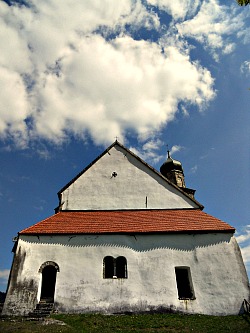
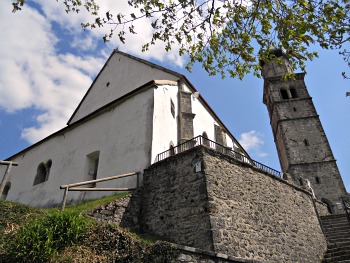
Zuglio lies in the Valle del But (But valley; also known as Canale di San Pietro), in the middle section of Carnia. It is, among the towns and villages in this region, the one that offers the most interest – at least from a cultural and historic point of view. Having said that, there are also several noteworthy naturalistic sights to be enjoyed in the surrounding area.
Two monuments are particularly noticeable in Zuglio: the Church of San Pietro, which – perched high on a hill (see pictures above) – is by far the most notable religious building of Carnia (it is the “Chiesa Matrice” – which means that in ancient times it had jurisdiction over a broad territory), and a very important archeological site, with annexed museum.
It is because of the easy connections, good communications and its peculiar geographical position that this small Alpine town managed to be reached by the evangelical currents that were coming from Aquileia – at that time (we are in the first half of the 4th century AD) the most important seat of Christian life in the Roman province of Venetia et Histria.
The Church of San Pietro in Carnia
Between the 4th and 5th century, in the southern half of the Roman settlement two Proto-Christian basilicas were erected, most likely at the same time of the institution of the Diocese by the Aquileiese Bishop Cromazio (388-408). Remnants of a third basilica – perhaps built at the end of the 5th century – have been uncovered recently inside the church. In 1312, the Patriarch of Aquileia, Ottobono, contributed to the construction of the actual gothic church, with a single nave and three altars; of the previous building only the sacristy was maintained. This work was realized by incorporating the northern wall with the Roman windows that are visible to this day; care was taken also to save the Roman ‘bifora’ (double mullioned window), still existing (above, see another image of the church from an interesting angle).
At the end of the 14th century, and until the first years of the 1500s, important renovations were undertaken: the main intervention was the addition of a nave to the south, designed following the canon of the previous gothic building; a pulpit was also created with a staircase that allowed to climb to the upper sacristy, which was being constructed at the time. In the newly refurbished church there were four altars and a baptistery; then, at the beginning of the 1700s, further alterations were carried out. As a result, the church – with all the superstructures of the 1500s, 1600s and 1700s – has become the asymmetrical complex that we admire today, quite interesting from an architectural point of view.
Despite being plagued by successive thefts, important works of art are still being conserved within this church, amongst which are paintings, an ancient baroque organ, and statues such as that of Saint Peter – product of a 15th century German workshop. The altar of the “Madonna del Rosario” is a work of the painter and carver De Agostinis (1590), while there are several precious woodcarving works, such as the walnut staircase that leads onto the upper sacristy – which was also frescoed in 1582 by Giulio Urbanis – and the stalls of the choir, which date 1734.
The most notable woodwork, though, is the Christ (Crucifix) dating to 1550, situated on the lintel of the main arch. It is almost two metres tall, and it is also the production of a northern workshop. The wooden board (‘ancona’) in Renaissance style, with a depiction of Saint Anthony Abbott, is enclosed by two baroque frames. Behind the altar, the tiny original windows are still visible, as well as traces of ancient frescoes (‘sinopiae’) on the wall. The baptistery contains a goblet in red stone, oeuvre of an unknown artist dating 1659, while a wooden tabernacle – designed by Vincenzo Comuzzo – is dated 1661.
Externally, the main door and the portal are clearly gothic; the portico has visibly undergone transformations but it remains highly atmospheric (see picture below), while the Roman ‘bifora’ still is one of the defining features of this building. On the walls, on the main façade and in the columns are traces of different materials being ‘reused’, such as fragments of Medieval sculptures – some of which are still extant, and deposited by the archeological museum.
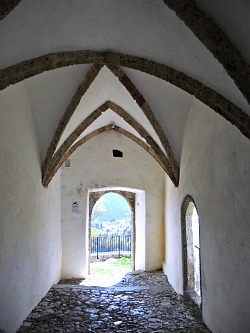
The open field lying on the small, flat plateau that one encounters on the way up towards the church has a very ancient history to tell: every year, on this site, in the recurring of Ascension day, a characteristic ritual – known as the ‘kissing of the Cross’ (“Bacio delle Croci”) – takes place. Every church that once belonged to the territorial jurisdiction of the Pieve di San Pietro brings here their processional cross – decorated with multi-coloured strings – as a homage to the main cross conserved in the Chiesa Matrice, and as a sign of dedication (in the image below, a view of the field just under the church with a sight beyond, over the But valley).
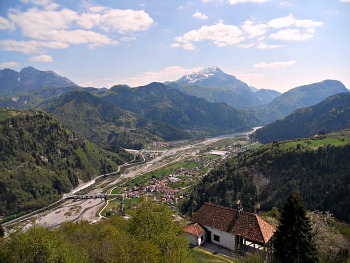
The Pieve di San Pietro is one of the eleven most important religious buildings in the region, but in many respects it can historically be considered the main church in the whole of Carnia – so much so that at one point it was also elevated to the rank of Diocese (seat of a Bishop): almost a ‘mountain emanation’ of the main Diocese of Aquileia. Over the centuries, however, the fortunes of the church have unfortunately been greatly scaled down; in a way, one could say it was for the best, as this place appears nowadays highly atmospheric in its ancient solitude, and perhaps slightly melancholic. The downside is that the church is now open only during the summer months or on holidays, and normally closed otherwise, in an attempt to prevent the thefts that have plagued the building in the past.
From the lower part of Zuglio – the area close to the river and next to the archeological site – one has the choice to reach the church either by road or on foot, via an historical “via Crucis” (Passion route) that climbs up the hill with a steep, narrow path which allows for wider and wider views as one proceeds.
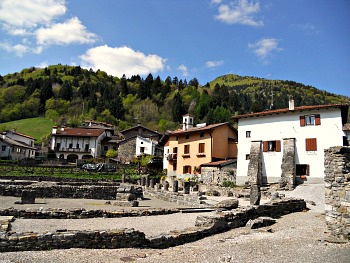
The need to build an archeological museum in Zuglio is due to its location on the site of the ancient Roman city of Iulium Carnicum. The museum started with various stages of research and subsequent excavations, which became a regular feature since the beginning of the 1800s, under the initiative of the French War Commissioner for the Italian Kingdom, Etienne-Marie Siauve.
It was only as late as 1955, though, that it was possible to offer a fixed location to the numerous findings that came from the excavations, thanks to the establishment of a museum located near the entrance to the archeological area of the forum (which is portrayed above). The museum exhibit is set up with the aim to provide an understanding of the ruins of Iulium Carnicum – the city that was located in Italy’s northernmost position during Roman times.
It was also situated in proximity of one of the major thoroughfares of the time, connecting the outpost of Altino (near Venice) through Concordia Sagittaria and Aquileia (then the most important centre in Friuli) to the northern province of Noricum, in what is today part of Austria. We are talking about the “via Claudia Augusta Altinate” – an important road whose course is not completely clear yet, but which has partly been revalued lately as an inter-regional long distance walking route between Italy and Austria.
Various aspects of life in the Roman city – such as the administrative, social, economic and religious – as well as the urban layout are illustrated in the museum through some of the most significant materials so far recovered, and with the aid of a wide range of educational panels (read below for more information on the museum).
The Botanical Garden “La Polse di Cougnes”
A very interesting but more unusual sight in Zuglio is the small botanical garden “La Polse di Cougnes” – which is certainly a most peculiar initiative. It was started a few years ago by a group of friends that were cultivating the desire for a secluded place in which to meet for prayer, study and research – and the splendid nature surrounding the ancient Pieve di Zuglio was immediately identified and chosen as the ideal setting for that. After being started by the founders, the idea was consolidated and became a community project, with the help of supporters and the working contribution of many volunteers.
The name “La Polse di Cougnes” is a program in its own right, as it encapsulates the history of the site and its vocation as a place of meditation and prayer: ‘Polse' designates a resting place in the old language of Friuli, and the ancient name of this locality is “Prât di Cougnes”, which literally translates as “the Field of the Snails”.
In 1996, on the site of the “Polse di Cougnes” foundation a small botanical garden – which in fact, more than anything, could be defined as a “physic garden” (or Giardino dei Semplici, following the old academic tradition) – was founded, and the initiative was immediately a success. Today, this place has evolved into a thematic, fully-fledged botanical garden that hosts about 1,200 species, largely indigenous, ordered on four different terraces and divided according to their properties or the characteristic of the plants themselves.
The first terrace is home to edible and poisonous species – displayed together side by side. The second and the third gather the officinal plants and those used to make liqueurs and bitters – an activity traditionally favoured in mountain settings; while in the fourth and last are grouped the most commonly found botanical families in the Carnian Alps, including also a significant contingent of protected plants. Lastly, at the end of a path traced in the fields, are gathered the ferns.
Connected to the botanical garden is also a laboratory for scientific research that is part of the last developments in the life of the garden, which now collaborates actively with the universities of Trieste and Udine. A herbarium has been developed here too, as well as a small collection of seeds and vegetal-based drugs. Didactic activity goes hand in hand with educational demonstrations for visitors – especially popular are the practical demonstrations on how to gather, conserve and use medicinal plants through the preparation of powders, decoctions, infusions, balms and tinctures; very appreciated are also the lessons on vegetal anatomy. Therefore, despite being conceived in the ancient tradition, the “physic garden” is today a lively hub of interest for scholars, professionals and plant lovers alike.
In line with the goals of its foundation, though, “La Polse di Cougnes” also hosts other structures, such as an ecumenical inter-faith centre for all confessions with a chapel for common prayer, an astronomy centre with a small observatory, an historical library with more than 20,000 volumes, a painting school that specializes in the creation of icons according to the traditional Oriental techniques, a hermitage hosted in an old barn, a reception centre for singles and groups, a refreshment point and lastly – as a note of curiosity – even a bell chiming school!
The only setback – so to speak – is that the garden is open only seasonally, from half June to half September, but this is the best period in which to admire the plants; also, it is normally closed on a Monday (unless it is a holiday).
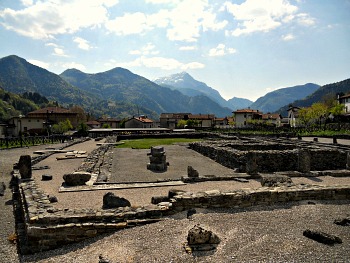
The Archaeological Museum in Zuglio
As anticipated earlier, the Civic Archaeological Museum in Zuglio was instituted in 1995, and it is hosted in an historical building which has been restored after the 1976 earthquake. The museum offers a panoramic view of the actual state of archaeological research in Friuli and especially in Carnia, with a particular reference to the local reality of Zuglio, where the excavations have brought to light the remains and many finds from the Roman city of Iulium Carnicum (see an image of the forum above).
Prior to the institution of the Archaeological museum, the material was kept at a local Antiquarium that, as it appears from a series of manuscripts, existed already at the beginning of the 1800s – at the time of the first regular digs, which started to take place thanks to the initiative of the Kingdom of Italy's War Commissioner. Hereafter, a more detailed description of what can be seen in the museum follows.
The route of the exhibit has the goal of making known the territory historically gravitating on Zuglio in ancient times. The finds – often separated between the civic collections of various localities across Carnia – are the result of occasional findings but also of systemic excavations, and they refer to a wide time span that covers the period between the Pre-historic age and the late Middle Ages.
The room dedicated to the Pre-Roman times illustrates the most ancient phases of population in Carnia, witnessed by the finding of flint artifacts from the Middle Paleolithic and Mesolithic periods, as well as by other tools in copper, bronze and ceramic from Invillino. The Iron Age is also well documented, thanks to the research carried out in Zuglio itself, in Misincinis (Paularo) and in Verzegnis. Particularly interesting is a reconstruction of a section of the necropolis and of some of the burials in Misincinis, which can be dated from the 8th to the 4th century BC. Worth mentioning are also the Celtic weapons found in Raveo and Lauco, and the inscription in Venetian alphabet coming from Agrons (Ovaro).
The Romanization process in Carnia seems to have started at the end of the 3rd century BC, when the Romans came into contact with the local populations (Paleoveneti and Celts) and started a gradual, progressive process of integration: in an epigraph from Amaro, dating to the first half of the 1st century AD, a name of venetian origin can be detected.
At the time of the Roman domination, the territory controlled by Iulium Carnicum was particularly vast, as it was the only urban nucleus to be found over quite a wide stretch of territory within the eastern Alps. The city was located along one of the connecting routes between Aquileia, Concordia Sagittaria and the Noricum province; near where Timau is today there was probably the custom house before the boundary at Passo di Monte Croce Carnico. An overview on the history of Carnia from the ancient times to the Middle Ages is presented at the end of this section.
On the first floor are located some of the more meaningful materials that were found in the course of the excavations carried out in Zuglio. The Roman settlement was located in correspondence of the actual town: the monumental part developed in the flat area comprised between the river But and the hill, with the most representative buildings of the Forum – the economic, politic and religious centre of the city – as well as other buildings of public utility. The didactic apparatus of the first room is in fact dedicated to the area of the Forum. This part of the ancient city – and the basilica that was the heart of it – had been first explored between 1807 and 1808, and during those digs several bronze artifacts were found; these finds are conserved today at the National Archaeological Museum at Cividale – one of the most important in Friuli. The entire complex of the Forum was finally brought to light only between 1937 and 1938, in occasion of the Augustan bi-millenary anniversary.
The following room is articulated into two successive sections. The first section is centered around the public buildings that have been discovered up to now – amongst which is an important thermal compound located originally in the vicinity of the Forum, and equipped with an important decorative cycle in fresco and plaster. The second section is dedicated to the private housing instead. A series of panels and a meaningful selection of finds – amongst which is a little bronze statue representing a child Dionysus – provide the necessary elements in order to get to know the planimetric disposition and the decorative apparatus of the houses, as well as other aspects linked to domestic life in Roman times.
On the second floor, the first room is once again dedicated to the history of Zuglio in Roman times. Here, some inscriptions illustrate the themes relating to the funerary world and religious life, while the rest of the material offers precise indications as to how the commercial activities were carried out in the city given its nature of a ‘transit’ place, the medium/short-range exchanges, and the local productions – especially those in common raw ceramic.
The last room is dedicated to the history of Zuglio from the Proto-ancient era to the Renaissance period. The two Early-Christian (“Paleocristiano”) basilicas erected in the southern area of the settlement are perhaps to be put in relation to the creation of the diocese of Iulium Carnicum, wanted by the bishop Cromazio (388-408). The remains of another important Early-Christian basilica were located by the church of San Pietro, which has also brought back some late Middle Age reliefs that can be dated between the 6th and 9th century AD. A choice of the most representative and meaningful specimens of ancient architectonic decoration – both in marble and limestone – are also exhibited here together with ceramics from the Renaissance period, which were found by the village of Zuglio as well as on the hill where the church of San Pietro still is today.
Return from Zuglio to Italy-Tours-in-Nature

New! Comments
Have your say about what you just read! Leave me a comment in the box below.